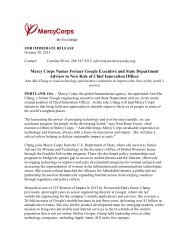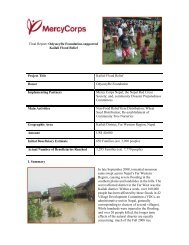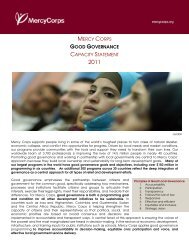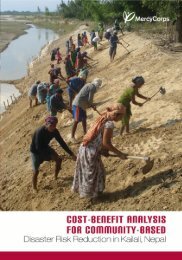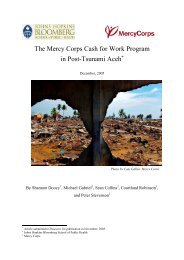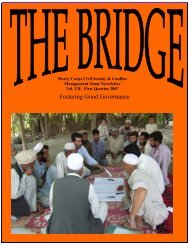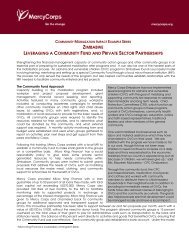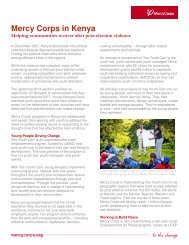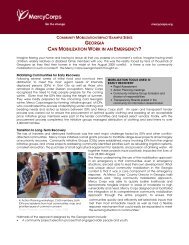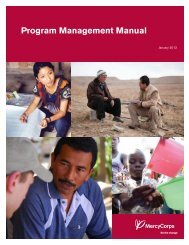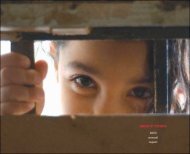Figure 3: Current Condition of Assessed Infrastructure Projects7% 3% School maintenance was secured primarilyExcellentthrough government support or parent6%38%contributions. Throughout the region, parentsGoodregularly contribute to annual maintenanceAveragecosts, which usually support small repairs andPoorpainting that are done by teachers during the16%summer. In Kyrgyzstan, the government hasNot Functioningtaken responsibility for school upkeep and hasNever Usedoutlawed the collecting of money from parents30%for this purpose. The schools that wererehabilitated or built with project support inKyrgyzstan were all in very good condition. Only one school, in the Sari Kenja Community of the RashtValley of Tajikistan, received a “poor” rating. The Department of Education had a project underway toconstruct a new school building in this community, likely lessening community motivation to contributeto maintaining the older school building.Projects addressing basic utilities, such as gas, electricity and water (irrigation and drinking),were highly appreciated in communities and often benefited from community organized repairs.Communities usually appointed water user groups or individuals to care for these projects, and feeswere collected for regular maintenance or on an as needed basis to ensure repairs. In the few caseswhere water projects were not functional due to issues of maintenance, design issues were oftencited, with community members feeling less involved in the process.Projects such as youth and community centers, sports fields, dykes and dams had less clear systemsfor maintenance, and as such, were generally in poorer condition or had not yet had any significantmaintenance done. These types of projects do not traditionally have maintenance structures in place,so it has been harder to ensure sustainability. See Figure 4 for a summary of project quality acrossall categories. 17Figure 4: Project Quality by CategoryEducationWaterUtilitiesSocialHealthRoadsEnvironment0 10 2030Good or ExcellentAveragePoor or Not FunctionalSub-standard construction, due to alack of specialist labor on the project,was cited in one case where conditionwas rated as “poor”. In YaldamichCommunity of Rasht Valley, somerooms of the CAIP-constructedmaternity ward are not being fullyutilized due to problems with theirconstruction. These problems wereattributable to the choice of unskilledlabor from community members,used to reduce overall project costsand help meet community contributionrequirements for the project.5152517 “Utilities” include gas, electricity and communications projects; “Social” projects include youth centers, sport fields, a bathhouse, a communitysquare and a commercial center; “Health” projects include work on medical points and maternity wards; and “Environment” projects includegarbage collection points, dykes, dams and mud-flow channels.18Sustainability Field Study
2. New Community InitiativesMost communities have continued to undertake collective community activities. The majority ofCAG members (93%) and general community members (88%) alike said that collective activities orproblem-solving have occurred in their community during 2007. In cases where CAG members statedno such activities have taken place, others in the community reported some level of activity, thoughoften this was for hashars 18 or holiday celebrations. More importantly, 42% of CAG members, representing35 of the 51 communities, reported that the community had worked collectively onnew projects or repairs to existing infrastructure, beyond traditional hashars, in 2007. Theseactivities varied from building a new mosque, organizinga mass livestock vaccination campaign and expandingdrinking water systems to community-funded andorganized repairs of existing transformers, roads andwater infrastructure. These activities demonstratethat many communities have continued to activelyengage in problem-solving. Rajabov Yuldosh, fromthe village of Jar Kyshtak in Osh, Kyrgyzstan, attestedthat, “[<strong>Mercy</strong> <strong>Corps</strong>] taught us many things, methodsof work. People got motivated by the project and thenimplemented six other projects. Some projects wererealized by ourselves, some of them with NGOs andSANDY SHEARD, 2007 FOR MERCY CORPSlocal government.”Built Confidence for Collective Community ActionCommunity members and CAG leaders alike emphasized that once the first physical project in theircommunity was successfully implemented, their willingness to contribute resources and participate inthe prioritization, design and implementation process grew noticeably. “If we had trusted <strong>Mercy</strong> <strong>Corps</strong>in the beginning we could have done more projects, maybe got a transformer. <strong>Mercy</strong> <strong>Corps</strong> explainedthat if we are quick with the first project there may be time for a second, but we were too slow tounderstand the benefits, so missed this opportunity,” reflected Nasanov Davlatali, a CAG member fromJarbulok-Kalam in the Asht Raion of Sughd Oblast where PCI operated for two years. The approachof multiple project cycles in any given community was a deliberate part of the program design. Thesefindings confirm the original hypothesis (that investment in building the confidence of communities tooffer their time and energy in managing and implementing development projects) is critically importantto fostering sustained collective action and the possibility of independent project implementation inthe future.Increased Advocacy for Community ResourcesCAIP and PCI communities are now more actively seeking support for community needs andprojects. Forty-four percent (44%) of CAG members reported seeking outside funding from NGOs,government, the UN or similar organizations, in the initial six or seven months of 2007, while only 26%reported having done so at any time prior to implementation of <strong>Mercy</strong> <strong>Corps</strong>’ program in their community(See Figure 5). CAG members frequently cited lessons they learned during program implementationfor this increased activity:1) Twenty-four (24) CAG members mentioned proposal, budget or project development skills as aprogram lesson that they continue to use; and18 Community workdays, often organized annually to clean and repair canals or streets.Understanding What Promotes Lasting Change at the Community Level19



